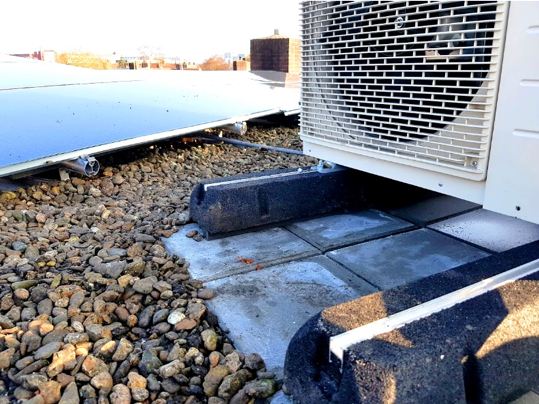Outdoor units of climate systems, such as air conditioning or heat pumps, can cause two types of noise problems: impact noise and/or airborne noise. Especially placed on a lightweight surface, such as a wooden construction of a dormer window or another type of extension, impact noise can cause a lot of nuisance in the form of a constant hum. On this tips page you can read about the question of a customer concerning his outdoor unit, the solution we provided and the achieved result.
The customer's question
"Dear Sir/Madam,
I hope you can provide me with some advice. Recently a heat pump was installed with an outdoor unit placed on top of my dormer window. Ever since the heat pump functions, there is significant noise pollution in the attic room with the dormer window. When the outdoor unit is fully operational, you can clearly perceive a low hum. I supsect the outdoor unit to cause the roof to vibrate resulting in contact noise. I have listened near the dormer window myself and can hardly imagine that this airborne noise coming in through the window and being so audible.”
Solution for the customer (impact noise)
The situation
In the customer's situation, the outdoor unit is located on the outside of a light construction. The customer also indicates that he perceives a hum sound, which indicates a problem caused by impact noise. Many outdoor air conditioning and heat pump units are placed on plastic beams, or big foots, which form a (rigid) connection between the unit and the roof.
The solution
In order to reduce this impact noise, a vibration-isolating product was used containing sufficient stability and resilience: Regufoam D300 with a thickness of 25 mm. Underneath the corners of the big foots, blocks of Regufoam vibration insulation were applied to reduce the nuisance. A Regufoam mat was cut with a sharp knife into four squared blocks that have the same width as the big foots of the unit (minimum size of the blocks must be 100 x 100 x 25 mm). From one mat of Regufoam more than eight pieces can be cut.

Fine-tuning the solutionBecause there are countless different air conditioning units, roof constructions and situations, you may have to adapt this solution to your situation in order to achieve the optimal result. So in case your result is a bit disappointing, you can improve the result by applying the following tips:
- Tip 1: The subsurface is too light
On a very lightweight surface, such as a wooden roof, improvement can be achieved by adding extra mass. Remove the gravel from the place where the unit will be placed and place several concrete tiles on this spot, in such a way that they do not wobble. Put the gravel back around the tiles and place the unit on the concrete tiles, with the blocks of Regufoam between the units big foots or feet and the tiles. This usually results in an improvement of a few decibels.
- Tip 2: Still not good enough…
If you can still hear low hums, the 25 mm pieces of Regufoam may not be thick enough for the lowest frequencies. Double pieces of Regufoam provide a longer 'travel way' and enhance the result. Glue the two Regufoam cubes together with sealant. Do not make the pieces thicker than 50 mm, this might cause the unit to wobble and allows for play on the pipes as a result!
"Dear Sir/Madam,
I have received the Regufoam, and it has clearly reduced the noise pollution. The sound is not completely gone yet, but I suspect that the remaining sound rather consists of airborne than of contact noise. So, thank you so much for the solution!”
Reducing airborne noise
As you have read, the problem with this outdoor unit consisted of both impact- and airborne noise. The emission of airborne noise can be reduced by placing a partial housing around the device. A housing can consist of several walls made of heavy sheet material (preferably four) such as waterproof plywood. The inside of these walls should be equipped with Stratocell Whisper, an LDPE plastic product that is suitable for outdoor applications. Finish the ends of the Stratocell sheets with a profile/plank so that the rain can minimally penetrate the plates. Because even though Stratocell withstands moisture, the drier the material remains, the higher the absorption values. Make sure that the walls cannot be blown over by wind! Provide enough space around the unit for the supply and exhaust of air, about which you can find information in the documentation of your device.
Installation tips
Regufoam is rot-resistant, hydrolysis-resistant and insensitive to fungi, but should not get too wet. Water inside the product greatly reduces the vibration-insulating properties of the material, and frost could cause damage to the material. Before applying the Regufoam pieces tape sides with PU Finishing Tape. This thin adhesive tape ensures that moisture cannot penetrate. Ideally, Regufoam is mounted with a sealant and can be cut to size with a sharp knife.
Industrial applications
As for the application of Regufoam underneath large sized units, with multiple fans or industrial applications, a calculation must first be performed in order to determine which type of Regufoam can be used. To this end, we need information with regards to the weight of the unit(s), the interface with the foundation (the size of the legs for example), and if available, the speed at which the unit rotates. When applying vibration insulation (Regufoam), make sure that the unit is stable so that no play can occur on the pipework.
Questions? 
Do you have any questions about this topic? Please contact us, we will be happy to answer your questions as soon as possible.

 Sound Insulation
Sound Insulation  Soundproofing
Soundproofing  Vibration Isolation
Vibration Isolation  Silent Ventilation
Silent Ventilation  Accessories
Accessories  Thermal & Acoustic Insulation
Thermal & Acoustic Insulation